
A jumper or jumper dress, pinafore dress or informally pinafore or pinny is a sleeveless, collarless dress intended to be worn over a blouse, shirt, T-shirt or sweater. Hemlines can be of different lengths and the type of collar and whether or not there is pleating are also variables in the design.
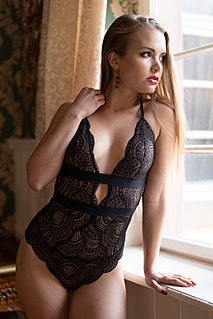
A bodysuit is a one-piece form-fitting or skin-tight garment that covers the torso and the crotch, and sometimes the legs, hands, and feet, and cannot be used as a swimsuit. The style of a basic bodysuit is similar to a one-piece swimsuit and a leotard, though the materials may vary. A bodysuit, unlike a swimsuit or leotard, has snaps, hooks or velcro at the crotch. Thong or T-front thong bodysuits usually have the crotch opening moved up to the front to underbelly area to increase the wearer's comfort. A bodysuit may have sleeves and varying shoulder strap and collar styles. Bodysuits can be made from a number of fabrics, including cotton, lace, nylon, etc. In general, textile bodysuits include expandable fiber such as spandex for a better fit to the shape of the body.

A coat typically is an outer garment for the upper body as worn by either gender for warmth or fashion. Coats typically have long sleeves and are open down the front and closing by means of buttons, zippers, hook-and-loop fasteners, toggles, a belt, or a combination of some of these. Other possible features include collars, shoulder straps and hoods.

A chemise or shift is a classic smock, or a modern type of women's undergarment or dress. Historically, a chemise was a simple garment worn next to the skin to protect clothing from sweat and body oils, the precursor to the modern shirts commonly worn in Western nations.
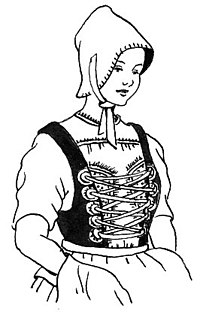
A bodice is an article of clothing for women and girls, covering the torso from the neck to the waist. The term typically refers to a specific type of upper garment common in Europe during the 16th to the 18th century, or to the upper portion of a modern dress to distinguish it from the skirt and sleeves. The name bodice comes from an older garment called a pair of bodies.

A pinafore is a sleeveless garment worn as an apron.
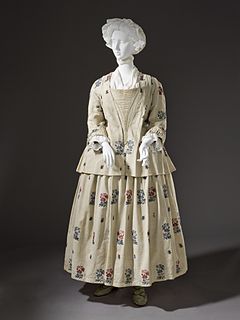
A bedgown is an article of women's clothing for the upper body, usually thigh-length and wrapping or tying in front. Bedgowns of lightweight printed cotton fabric were fashionable at-home morning wear in the 18th century. Over time, bedgowns became the staple upper garment of British and American female working-class street wear from the 18th to early 19th centuries, worn over petticoats and often topped with an apron. Made of sturdy cotton, linen, wool or linsey-woolsey, these bedgowns were simply cut to a T-shaped pattern, and were worn overlapped in front or with the front skirts cutaway. The term "bed gown" to describe this item of clothing was used as late as 1876.
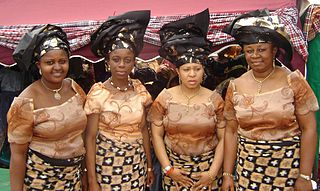
The wrapper, lappa, or pagne is a colorful garment widely worn in West Africa by both men and women. It has formal and informal versions and varies from simple draped clothing to fully tailored ensembles. The formality of the wrapper depends on the fabric used to create it.

A gown, from the Saxon word, gunna, is a usually loose outer garment from knee- to full-length worn by men and women in Europe from the Early Middle Ages to the 17th century, and continuing today in certain professions; later, gown was applied to any full-length woman's garment consisting of a bodice and attached skirt. A long, loosely fitted gown called a Banyan was worn by men in the 18th century as an informal coat.
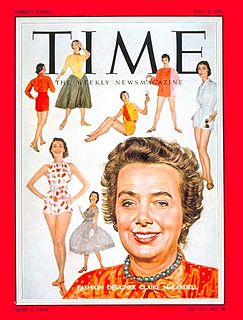
Claire McCardell was an American fashion designer of ready-to-wear clothing in the twentieth century. She is credited with the creation of American sportswear.

A banyan is a garment worn by European men and women in the late 17th and 18th century, influenced by the Japanese kimono brought to Europe by the Dutch East India Company in the mid-17th century. "Banyan" is also commonly used in present-day Indian English and other countries in the Indian Subcontinent to mean "vest" or "undershirt".
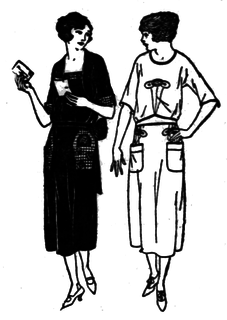
Nelly Don Inc. was a clothing manufacturer and distributor from 1956 to 1978. It was founded by Nell Quinlan Donnelly Reed in 1916 as the Donnelly Garment Company and was renamed to Nelly Don after the founder retired and sold her interest in the company.in 1956.

A Mother Hubbard dress is a long, wide, loose-fitting gown with long sleeves and a high neck. It is intended to cover as much skin as possible. It was devised in Victorian western societies to do housework in. It is mostly known today for its later introduction by Christian missionaries in Polynesia to "civilise" those whom they considered half-naked savages.

A wrap dress is a dress with a front closure formed by wrapping one side across the other, and knotting the attached ties that wrap around the back at the waist or fastening buttons. This forms a V-shaped neckline and hugs the wearer's curves. A faux wrap dress resembles this design, except that it comes already fastened together with no opening in front, but instead is slipped on over the head. A wrap top is a top cut and constructed in the same way as a wrap dress, but without a skirt.

Fashion in the period 1900–1909 in the Western world continued the severe, long and elegant lines of the late 1890s. Tall, stiff collars characterize the period, as do women's broad hats and full "Gibson Girl" hairstyles. A new, columnar silhouette introduced by the couturiers of Paris late in the decade signaled the approaching abandonment of the corset as an indispensable garment.

The preservation of fabric fibers and leathers allows for insights into the attire of ancient societies. The clothing used in the ancient world reflects the technologies that these peoples mastered. In many cultures, clothing indicated the social status of various members of society.

Ballet flats are women's shoes for everyday wear which are similar to/inspired by a women's ballet shoes, with a very thin heel or the appearance of no heel at all. The style sometimes features a ribbon-like binding around the low tops of the slipper and may have a slight gathering at the top-front of the vamp and sometimes a tiny, decorative string tie. Ballet slippers can be adjusted and tightened to the wearer's foot by means of this string tie.

Sportswear is an American fashion term originally used to describe separates, but which since the 1930s has come to be applied to day and evening fashions of varying degrees of formality that demonstrate a specific relaxed approach to their design, while remaining appropriate for a wide range of social occasions. The term is not necessarily synonymous with activewear, clothing designed specifically for participants in sporting pursuits. Although sports clothing was available from European haute couture houses and "sporty" garments were increasingly worn as everyday or informal wear, the early American sportswear designers were associated with ready-to-wear manufacturers. While most fashions in America in the early 20th century were directly copied from, or influenced heavily by Paris, American sportswear became a home-grown exception to this rule, and could be described as the American Look. Sportswear was designed to be easy to look after, with accessible fastenings that enabled a modern emancipated woman to dress herself without a maid's assistance.

Nell Donnelly Reed was an American fashion designer and businesswoman, known for her house dresses, who founded the Nelly Don brand.
Popover is a type of dress originally designed by Claire McCardell in 1942. The outfit type became the basis for a variety of wrap-around dresses.




















